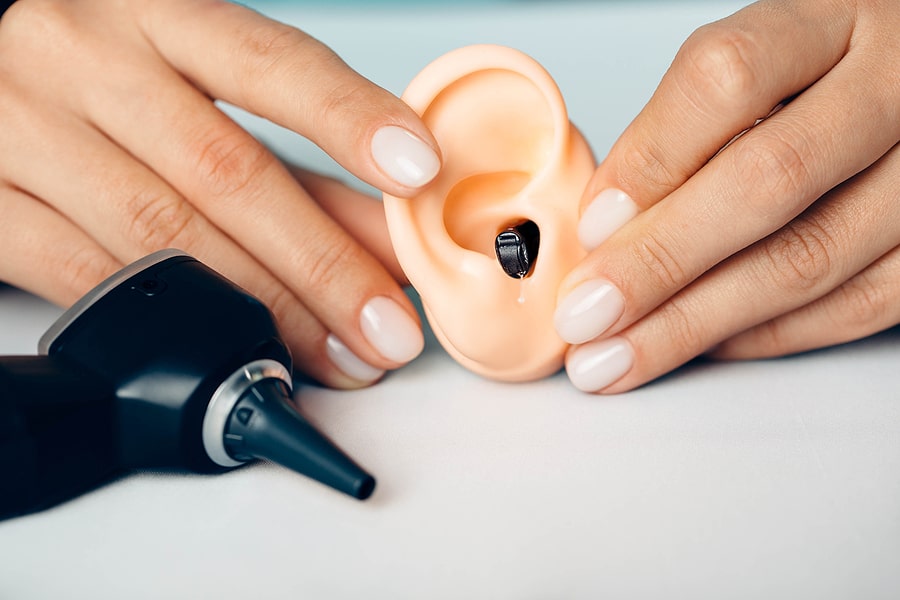
The innovative technology behind hearing aids is diverse, but they come together to create a solution. This solution changes the status of people plagued by one degree of hearing loss to another, giving them a chance to live and enjoy full-spectrum hearing.
Hearing aids are versatile, and this feature is characterized by two fundamental hearing options – Behind-the-ear (BTE) and in-the-ear (ITE) hearing aids. These two types are the most popular and are the basis for the design and aesthetics of hearing aids. Each of these types of hearing aids has its advantages and disadvantages, and this may affect your choice. To help, we have put together their differences to help you learn and choose the most suitable option.
Behind-the-Ear Hearing Aids
The behind-the-ear (BTE) style is a widely used classic known for its reliability and versatility. In this design, the main body of the hearing aid rests comfortably behind the ear and is connected to a custom-molded earpiece that fits securely into the ear canal.
Advantages of BTE Hearing Aids
- Powerful Amplification: One of the standout features of BTE hearing aids is their ability to provide great sound amplification. This makes them a preferred choice for individuals with severe to profound hearing loss, ensuring that even the softest whispers are captured and delivered.
- Long Battery Life: BTE devices’ larger size allows them to incorporate substantial batteries that can last a while. This contributes to the device’s overall longevity and reduces the frequency of battery replacements. This practical advantage is mostly beneficial if you prefer uninterrupted, extended periods of use.
- User-Friendly Controls: BTE hearing aids often have user-friendly controls to make them easier for individuals with dexterity problems. These controls typically include options for adjusting volume levels and selecting different program modes, providing a customizable and adaptable listening experience.
In-the-Ear Hearing Aids
In-the-ear (ITE) hearing aids offer users a sleek and discreet design that is more subtle in its approach to hearing. ITE devices are custom-molded to fit in the ear canal to provide a discreet and nearly invisible hearing aid option.
Advantages of ITE Hearing Aids
- Cosmetic Appeal: The most prominent advantage of ITE hearing aids is their cosmetic appeal. The smaller, custom-molded design allows these devices to sit undetected in the ear canal, making them virtually invisible to onlookers. This aesthetic advantage is preferred if you want subtlety and maintain a low profile while enjoying enhanced hearing.
- Less Interference with Accessories: Unlike their BTE counterparts, ITE hearing aids offer minimal interference with accessories such as glasses, hats, or other headwear. This characteristic makes ITE devices a preferred choice if you regularly wear accessories and want seamless use of hearing aid technology in your daily lives.
- Reduced Wind Noise: ITE hearing aids’ placement within the ear canal creates a natural barrier against wind noise. This feature is useful in outdoor settings, where wind can often interfere with sound clarity. With in-ear positioning, ITE devices shield against environmental factors like wind or rain to enhance the listening experience.
Choosing the Right Fit
The decision between BTE and ITE hearing aids is not a one-size-fits-all scenario but rather a personal choice influenced by many factors, and here are a few of them.
- Degree of Hearing Loss: Hearing loss is crucial in determining the most suitable hearing aid style. BTE aids, with their powerful amplification, are generally preferred for severe and profound hearing loss. Meanwhile, ITE aids are better for mild to moderate hearing loss.
- Cosmetic Preferences: Users who want a discreet appearance can choose ITE hearing aids because of these devices’ nearly invisible profile. On the other hand, individuals comfortable with a more visible device may choose the classic design of BTE models.
- Ease of Maintenance: The maintenance requirements of BTE and ITE devices are very different. BTE hearing aids’ larger size may be perceived as easier to handle and maintain. In comparison, ITE devices offer a sleek design, which may require more meticulous care due to their smaller size and in-ear placement.
Conclusion
The decision between these two styles is between devices and individual preferences and lifestyle requirements. Whether it is the BTE hearing aids that are versatile and cater to a wide age range. Or the comfort of the ITE hearing aids that are crafted to fit the unique contours of the user’s ear canal; these devices have one goal – to give persons with hearing loss a chance to experience the world and its sounds.
- How to Overcome Your Fear of Hearing Health - July 17, 2024
- Helping Your Partner Realize Their Potential Hearing Loss - July 3, 2024
- Why You Should Book a Professional Ear Cleaning - June 28, 2024
Request a Callback
That’s why we have a hearing care expert available to help.
If you have a question, or would like to speak to a professional privately about the challenges that you may be facing, then simply request a callback and we’ll call you for a friendly no-obligation conversation.
